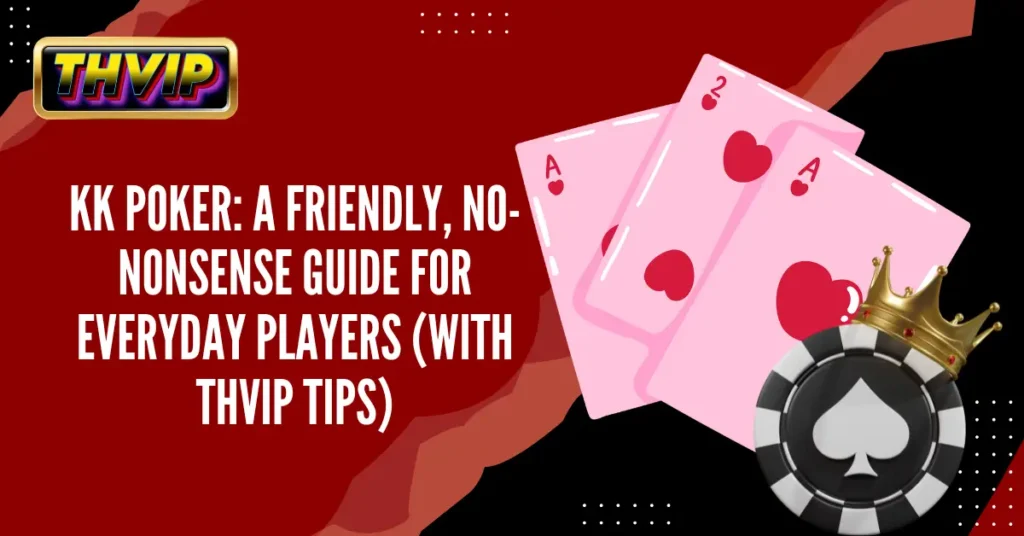If you’ve heard whispers about KK Poker and wondered what the buzz is all about, you’re in the right place. Think of this guide as a friendly coach sitting beside you, explaining the game in plain English—no jargon, no stuffy lectures. Whether you’re curious about how the app works, want to join a club, or simply wish to learn how to play smarter, we’ll cover it all. We’ll also sprinkle in THVIP-style tips: practical, value-first advice aimed at helping regular folks play more confidently and responsibly.
1. What Is KK Poker and Why Do People Love It?
KK Poker is a popular mobile poker platform that connects you to a club-based ecosystem—imagine a network of digital card rooms where you can find games around the clock. Players love it because it’s convenient, community-driven, and feature-rich. Instead of hopping from app to app, you can sit down in games that match your experience level, budget, and vibe.
In plain terms: KK Poker is like a neighborhood of poker clubs in your phone. You pick a good neighborhood, walk into a friendly room, and play.

Why it’s sticky:
- Clubs create community. You’ll see familiar names and styles—great for learning and improving.
- Flexible stakes. From micros to higher limits, there’s a seat for almost everyone.
- Feature set. Hand histories, multi-tabling, and tournament options keep the game fresh.
A quick analogy: Think of poker like learning guitar. First, you learn a few chords (rules). Then you practice rhythm (bankroll and discipline). Later you add solos (advanced strategy). KK Poker is the stage; your skills are the music.
2. How KK Poker Works: Clubs, Agents, and Games
Clubs are private or semi-private communities that host tables and tournaments. Many clubs are run by agents (or admins) who manage membership, communicate game schedules, and sometimes organize promotions.
What this means for you:
- You apply or get invited to clubs.
- Once inside, you’ll see cash tables and tournaments with different blinds, buy-ins, and formats.
Key points to remember:
- Reputation matters. Join clubs that have transparent rules, established moderators, and a track record of fair play.
- Communication is crucial. Good clubs share info clearly: game times, structures, payouts, and rules.
THVIP tip: Treat club selection like choosing a bank. You want safety, reliability, and clear terms—not mystery.
3. Getting Started: Setting Up Your Account the Smart Way
Step-by-step basics:
- Create your account on the KK Poker app and secure it with a strong password and available 2FA.
- Join a reputable club—ideally one that friends recommend or that’s well-reviewed by communities you trust.
- Verify rules and support: Know who to contact for dispute resolution or technical issues.
- Start at low stakes to get a feel for the player pool and app flow.
- Track your play from day one. A simple spreadsheet works wonders.
THVIP-style setup checklist:
- Security first: Unique passwords and device lock.
- Small start: Begin with a test deposit you’re fully comfortable with.
- Notes system: Use player notes; tag styles and habits.
- Session limits: Decide your maximum session length before you sit down.
4. Understanding the Games: Hold’em, PLO, and More
No-Limit Texas Hold’em (NLHE): The classic. You get two hole cards and combine them with five community cards to make the best five-card hand. It’s fast, intuitive, and great for beginners.
Pot-Limit Omaha (PLO): You get four hole cards, must use exactly two, and combine with three community cards. Action-heavy, swingy, and bankroll-intensive. Proceed with caution if you’re new.
Other formats you may find:
- Short Deck (6+ Hold’em): Fewer cards (2s–5s removed). Hand values shift; straights and sets show up more often.
- Spin-style or lottery SNGs: Small buy-ins with variable prize pools—fun, but variance can be high.
- Bounty tournaments: Knock out players for reward bounties—encourages wider ranges and creative play.
Choosing your game: If you’re brand new, start with NLHE. If you like action and can handle swings emotionally and financially, PLO is a thrilling next step.
5. Table Etiquette and App Features That Make Life Easier
Good etiquette = better games.
- Act in turn and avoid stalling.
- Be polite in chat. Tilt talk hurts you more than it hurts them.
- Protect your action. Don’t reveal or discuss live hands.
Helpful app features to master:
- Bet sliders & presets: Set standard sizes (e.g., 33%, 50%, 75%, 100%) to act quickly and consistently.
- Hand history & replay: Review key pots after sessions.
- Multi-tabling controls: Keep it to a number where your decision quality stays high.
THVIP tip: Pre-set your timebank strategy. Quick, consistent decisions reduce fatigue and prevent timeouts.
6. Bankroll Basics: THVIP-Style Money Management
If poker is a marathon, your bankroll is the fuel. You can have the perfect engine (skill) and still stall if you run out of gas.
Core rules to live by:
- Segregate funds. Keep poker money separate from life money.
- Set buy-in caps. For cash games, many players use 20–50 buy-ins for their main stake. For tournaments, aim higher (e.g., 100+ buy-ins) due to variance.
- Move down fast. If your bankroll dips below a safety threshold, drop stakes immediately—no ego.
Session planning:
- Pre-set loss limit: Decide a number where you’ll stop for the day even if the game is juicy.
- Pre-set time limit: Good poker needs a fresh mind.
- Review > chase. When the session ends, review hands rather than chasing losses.
THVIP mindset: Value first. Always ask: Is this seat, stake, or format giving me the best value for my current skill and bankroll?
7. Beginner Strategy: Play Fewer Hands, Win More Pots
The simplest winning adjustment for new players: tighten up.
Starting hands (NLHE basics):
- Premiums: AA–QQ, AK—play aggressively.
- Strong opens from late position: AJ, KQ, TT–77; widen selectively when you have position.
- Trouble hands to avoid early on: Weak offsuit aces (A8o–A2o), dominated kings (K9o–K2o), and offsuit gappers.
Post-flop principles:
- Top pair, good kicker is often a value hand at low stakes—bet for protection.
- Draws with equity (e.g., flush draws + overcards) can semi-bluff.
- Don’t pay off obvious strength. If the story screams strength and your hand is a one-pair bluff-catcher, fold and move on.
Key beginner habit: Position awareness. Act last, win more. It’s that simple.
8. Intermediate Moves: Position, Bet Sizing, and Pressure
Once you’re comfortable, start leveraging position and bet sizes to apply pressure.
Position:
- Late position (Button, Cutoff) lets you play more hands profitably.
- Defend blinds carefully; being out of position shrinks your edge.
Bet sizing:
- Small c-bets (25–33%) on dry boards to attack range advantage.
- Bigger bets (66–100%) on wet boards to charge draws and polarize range.
- Turn pressure: Many pots are won on turns. Plan turn barrels before you bet the flop.
3-bets & 4-bets:
- Value 3-bets with QQ+/AK versus early opens.
- Light 3-bets in position against frequent raisers; pick hands with blockers (A5s, KTs).
- 4-bet value vs. aggressive opponents; keep bluffs rare at lower stakes.
THVIP edge: Consistency over flash. You don’t need fancy moves every hand; you need the right move most of the time.
9. Reading Players Online: Patterns, Timing, and Tells
Online tells are about patterns, not faces.
Patterns to log:
- Preflop tendencies: Who opens too wide? Who never 3-bets?
- C-bet habits: Auto-c-bet on all boards? Over-fold to raises?
- Showdown lines: What hands do they take to showdown and from what positions?
Timing and bet size clues:
- Snap checks often mean weak or pot-controlling.
- Odd overbets at low stakes usually mean strength (but take notes; some bluff).
- Min-raises from passive players tend to be strong.
Use the app’s note system: Tag players as loose, tight, passive, or aggressive. Patterns pay.
10. Tournament vs. Cash Games: Which Fits You Best?
Cash games:
- You can buy in and cash out anytime.
- Deeper stacks emphasize post-flop skill.
- Lower variance than tournaments (usually).
Tournaments (MTTs/SNGs):
- Fixed schedule and a clear prize ladder.
- ICM pressure near the bubble and final tables.
- Higher variance—bankroll management is critical.
Which to choose?
- Limited time? Cash games.
- Chasing big scores and drama? Tournaments.
- THVIP approach: Mix formats, but track results separately to see where you truly win.
11. Security, Fair Play, and Choosing Trusted Clubs
Safety is not optional. You want transparent rules, active moderation, and clear dispute channels.
Checklist for trusted clubs:
- Admin visibility: Real profiles, responsive support.
- Anti-collusion measures: Education, monitoring, and quick bans.
- Payment clarity: Straightforward procedures and timelines.
Protect yourself:
- Device hygiene: Updated OS, antivirus, and secure Wi-Fi.
- Account hygiene: Strong password, 2FA, and no account sharing.
- Data hygiene: Don’t overshare personal info in chats.
THVIP reminder: If the terms feel fuzzy, walk away. Your peace of mind is part of your edge.
12. Promotions, Leaderboards, and Value Hunting (THVIP Mindset)
Promotions can add meaningful expected value (EV)—if you stay disciplined.
Where to look:
- Leaderboards: Reward high volume; great if you already play a lot.
- Rakeback or point systems: Consistent, reliable value.
- Special series/tournaments: Freerolls or overlay opportunities.
Smart promo play:
- Don’t chase a leaderboard at stakes you can’t beat.
- Track net results after rake, fees, and promos—not just top-line winnings.
- Prefer repeatable value (steady rakeback) over one-off lotteries.
THVIP mantra: Play your best stake, then layer promos on top. Not the other way around.
13. Common Mistakes and How to Avoid Them
Mistake #1: Playing too many hands.
Fix: Choose stronger starting ranges, especially out of position.
Mistake #2: Emotional calls.
Fix: If you say “I just know they’re bluffing,” and can’t prove it with logic or notes, fold.
Mistake #3: Bad bankroll discipline.
Fix: Use buy-in rules. Move down when the roll dips. Ego costs money.
Mistake #4: Ignoring table selection.
Fix: Favor tables with passive limpers and short-stacked calling stations.
Mistake #5: No review habit.
Fix: Mark hands during sessions. Spend 15 minutes post-session to examine 3–5 key spots.
14. Responsible Gaming: Play Long Game, Not Short Thrills
Poker is a skill game with luck in the short term. That’s the magic—and the trap. Respect the swings.
Set guardrails:
- Time boxes: Pre-decide when you’ll log off.
- Stop-loss/stop-win: Protect against tilt both ways—up or down.
- Balance life: Sleep, exercise, and hobbies make better poker brains.
If poker ever feels like pressure instead of play, step away. Real power is saying “not today.”
15. Final Thoughts: Building Skills That Compound
You don’t need to be a genius to win at KK Poker. You need habits. Start with good clubs, secure accounts, and a realistic bankroll. Learn the fundamentals—position, ranges, and bet sizing. Track your results. Review your hands. Over time, these small edges compound like interest in a savings account.
THVIP takeaway: Focus on value, safety, and consistency. Let the flashy plays be the dessert, not the main course.
FAQs
1) Is KK Poker good for complete beginners?
Yes—if you start small. Begin with NLHE micro-stakes, learn the app features, and practice tight, positional play. Use a THVIP-style bankroll (conservative and patient) to avoid stress.
2) What’s the safest way to choose a KK Poker club?
Look for transparent admins, active moderation, and clear rules on payments and disputes. Ask for recommendations from trusted friends or communities, and avoid clubs with vague terms.
3) Should I play tournaments or cash games on KK Poker?
Pick based on your schedule and temperament. Cash games are flexible and steadier; tournaments are exciting but swingy. Try both, track results, and lean into what fits your life.
4) How do I stop myself from tilting after a bad beat?
Stand up, breathe, and take a short break. Set pre-session stop-loss/stop-win limits. Review hands later with a cool head instead of reacting emotionally in the moment.
5) What’s one quick tip to improve right away?
Tighten your preflop range and play more hands in position. You’ll face fewer tough spots and keep pots manageable, which boosts your win rate instantly.








